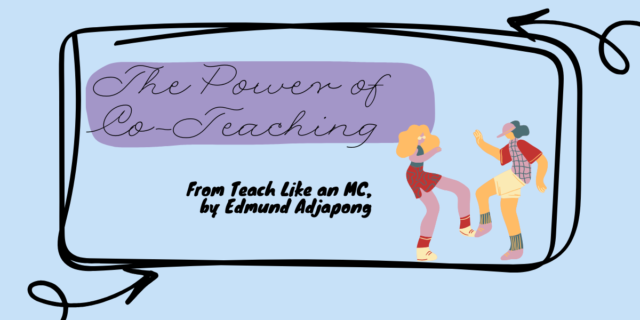Sonja Cherry-Paul and Dana Johansen are the authors of Teaching Interpretation: Using Text-Based Evidence to Construct Meaning. Both are completing their doctorates at Teachers College, Columbia University, and teaching full time. In part 1 of our conversation they talked about what interpretation really looks like in the classroom and what led them to write Teaching Interpretation.
Sonja Cherry-Paul and Dana Johansen are the authors of Teaching Interpretation: Using Text-Based Evidence to Construct Meaning. Both are completing their doctorates at Teachers College, Columbia University, and teaching full time. In part 1 of our conversation they talked about what interpretation really looks like in the classroom and what led them to write Teaching Interpretation.
In part 2, Dana and Sonja talk about their writing influences, their mentors, and what it was like to teach and complete doctorates while writing a book.
 You both are teaching full time and completing doctorates. How did you manage to write a book at the same time?
You both are teaching full time and completing doctorates. How did you manage to write a book at the same time?
When you’re doing something you truly love, you find the time. Like most teachers, we’re stretched incredibly thin. But a common thread running through our lives is a commitment to practice. We view everything we do through the lens of practitioner research: how can we teach this better? how can we make our teaching stick? how can we help our students grow exponentially during our year together? We push ourselves to answers these questions, knowing the answers are not static and will change from year to year, unit to unit, even day to day. This may seem daunting, but we are invigorated by this challenge and fortunate enough to be surrounded by incredible educators who are too. We maintain balance by treasuring the time we spend with family and friends, enjoying long walks with our dogs, and grabbing the chance to read a great book or catch up with a favorite television show.
Who are your inspirations?
The unique ways in which many of our colleagues approach instruction and help students learn is inspiring. Whenever we’re struggling with a teaching concept, it’s incredibly helpful to reach out to other teachers for insights and new perspectives. Also, our shelves are stacked with books by amazing practitioner/authors who put great teaching strategies at our fingertips. Lucy Calkins is such a beautiful writer! Curling up with one of her books is like reading the latest must-read novel. The way she helps us see inside a topic to the steps required to teach it well, combined with her wonderful way with words, is inspiring. But most of all, our students inspire us. When Joe, who has dyslexia and difficulty writing, proclaims, “I can take a picture of this graphic organizer with my iPad and complete it on the computer,” or Tara announces, “I finished my chapter book in a week,” we are in awe. We continue to be profoundly inspired by the ways our students challenge themselves and work so hard to reach their goals.
You seem to find inspiration everywhere. You write that using digital texts can make a difference. What role do you think digital texts play in classrooms now, and do you see them playing a greater role in the future?
As educators wrestle with how to teach twenty-first-century skills, the conversation centers on digital literacies. Everywhere we look we see people reading and taking in information using smartphones, tablets, and other electronic devices. We’ve broadened the definition of reading to include the way we process and come to understand all texts: videos, photographs, illustrations, as well as words on paper or screen. Innovations in technology will continue to change the ways we access information. Students who struggle to read traditional printed texts are able to use a variety of features when working with digital texts, including audio components. They can listen to interviews or watch a digital short. Embracing our students and their digitally mediated lives means acknowledging and honoring the forms of learning they find meaningful.
What was the writing process like for you? What do you like about it, and what do you find most challenging?
We are each other’s sounding board, so the writing process was therapeutic. We laughed, screamed, and vented about the successes and frustrations of teaching. Our writing sessions were the best part of our week. Teaching can be isolating, and our collaboration let us voice our doubts about instruction and problem-solve together. We learned from each other and strengthened our practice. After every meeting, we were excited to go back to our classrooms and try out the strategies we’d brainstormed. As doctoral students we spend a great deal of time immersed in educational theory and formal, academic writing. The writing in this book is grounded in practice, our true passion, and was therefore a joy. That being said, we experienced our fair share of challenges, as all writers do. We had to make hard choices about what to include and what to leave out. Another challenge was finding a structure for delivering our ideas clearly; we tried and discarded a variety of formats. We were eventually able to communicate our ideas in a way we believe is user-friendly and engaging: readers know what to expect from each chapter and can access the information easily. Writing this book has truly been a journey; we’ve grown so much as educators. Looking back, we realize we wrote the book as much for ourselves as for our readers.
Read a sample chapter of Teaching Interpretation Using Text-Based Evidence to Construct Meaning and be sure to check out Dana and Sonja’s blog. You can also follow them on Twitter; join the conversation using hashtag #tchinterp
Tweets by @LitLearnAct
Tweets about "#tchinterp"


